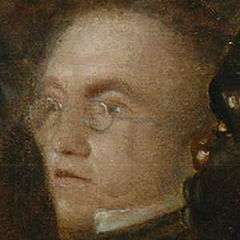William Morgan (abolitionist)
William Morgan (1815–c.1890) was a leading member of the Birmingham Anti-Slavery Society[3] whose members were very influential in abolitionist movements in Britain. He became the Town clerk in Birmingham[3] and gave a collection of books to Birmingham Library.[2]
William Morgan | |
|---|---|
 William Morgan in a detail from a painting at the National Portrait Gallery.[1] | |
| Born | 1815 |
| Died | c. 1890[2] |
Morgan was the third son of the Reverend Thomas Morgan.[4]
Morgan was trained as a solicitor and worked in Birmingham.[5] He was an active member of the Birmingham Anti-Slavery Society which campaigned for abolition of slavery in the British Empire in 1838. On the anniversary of the abolition a celebration was again held in Birmingham and it was Morgan who distributed information and invitations to the local Sunday Schools.[6]
Morgan was a founder of the local Baptist Union and served as secretary to the Birmingham Anti-Slavery Society[5] when British slavery was made illegal (in 1838). The picture above shows him at the 1840 Anti-Slavery Convention which was organised by Morgan's colleague Joseph Sturge. Morgan served as a secretary at the 1840 convention. He continued to work with Sturge during the 1850s.
In 1866, the British and Foreign Anti-Slavery Society sent Morgan to Jamaica.[5]
Morgam had married Henrietta Barnard on 6 March 1841 from Nailsworth in Gloucestershire.[4]
Works
- The Arabs of tía City or a Plea for Brotherhood with the Outcast - Address to the YMCA, Birmingham, 1853 (when he was Town Clerk of Birmingham), Hudson and Son, London
References
- National Portrait Gallery
- William Morgan at Connecting Histories.org.uk, accessed 29 July 2008
- The Birmingham Anti-Slavery Society, Connecting Histories.org.uk, accessed 29 July 2008
- The Baptist Magazine, Baptist Missionary Society
- Civilising Subjects: Metropole and Colony in the English Imagination 1830-67, Catherine Hall, ISBN 978-0-7456-1821-0
- The Culture of English Antislavery, 1780-1860, David Turley, 1991, p.93, ISBN 0-415-02008-5